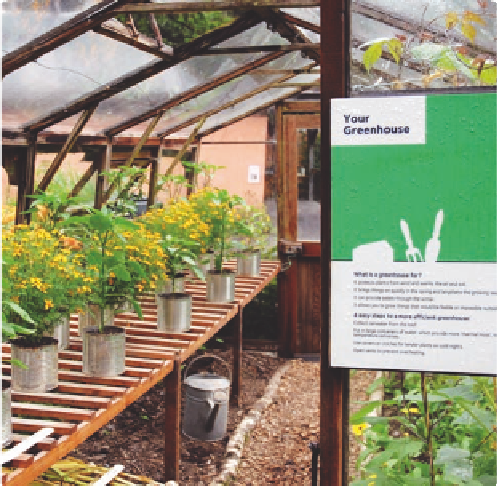Travel Reference
In-Depth Information
Pride of place is the hydro-powered lift that
takes you from the ticket-office fifty metres up
to the Centre, where exhibitions cover just about
every eco technology under the sun, from solar
thermals to wind turbines and vast woodchip
boilers. The potential of wind power for Britain's
energy requirements, for example, is one of
CAT's key messages, and a vast multi-blade
windmill has been modified into a “wind seat” so
you can feel the full force of wind power. “Britain
receives 40% of Europe's wind energy”, says the
signage, as if anyone in gale-battered Britain
didn't already know.
But CAT isn't solely about demonstrating the
power of alternative energy. There's an Eco-
House, where you can learn how to decrease
your home's carbon footprint, and a “Mole-Hole”
- an underground cave with model organisms
that are highly magnified to illustrate how many
creatures in the soil are killed by pesticides.
And of course, energy-wise, CAT practises what
it preaches. Not only does it run its restaurant,
offices, conference centre and lifts using wind,
solar and hydro power, it also creates so
much surplus electricity that it sells it to the
national grid. That would be impressive for a
015 the CeNtRe
foR alteRNative
teChNoloGy, waleS
When a small group of scientists
and engineers founded the
Centre for Alternative Energy
in Powys in 1973, their
ambitious outdoor project
was regarded by many as a
fanciful experiment rather
than a means to investigate
applicable, cutting-edge
technology. For the founders,
however, it was a vital focal
point for them to test theories
as well as create a showcase
of their work for anyone who
cared to take an interest. That
was in the days when going
green was considered extreme.
Thirty years on, many of the
fringe technologies that CAT
has helped develop are now
mainstream.
The hydro-powered lift; a poppy growing in 30cm of
soil on top of slate waste; interactive wind tunnel; a
demonstration greenhouse






















Search WWH ::

Custom Search